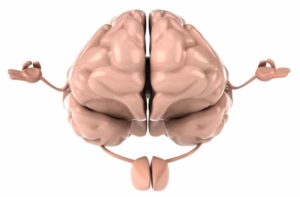Improve Psychological Health with Mindfulness Training at Work
By John M. de Castro, Ph.D.
“As an executive coach and physician, I often sing the praises of mindfulness approaches and recommend them to clients to manage stress, avoid burnout, enhance leadership capacity, and steady their minds when in the midst of making important business decisions, career transitions, and personal life changes.” – David Brendel
Work is very important for our health and well-being. We spend approximately 25% of our adult lives at work. How we spend that time is immensely important for our psychological and physical health. Indeed, the work environment has even become an important part of our social lives, with friendships and leisure time activities often attached to the people we work with. But, more than half of employees in the U.S. and nearly 2/3 worldwide are unhappy at work. This is partially due to work-related stress which is epidemic in the western workplace. Almost two thirds of workers reporting high levels of stress at work. This stress can result in impaired health and can result in burnout; producing fatigue, cynicism, and professional inefficacy.
To help overcome unhappiness, stress, and burnout, mindfulness practices have been implemented in the workplace. Indeed, mindfulness practices have been shown to markedly reduce the physiological and psychological responses to stress. As a result, many businesses have incorporated mindfulness practices into the workday to help improve employee well-being, health, and productivity and reduce burnout and turnover.
In today’s Research News article “A Stress Reduction Program Adapted for the Work Environment: A Randomized Controlled Trial With a Follow-Up.” (See summary below or view the full text of the study at: https://www.ncbi.nlm.nih.gov/pmc/articles/PMC5954607/ ), Lacerda and colleagues recruited employees at two business locations who complained of stress and randomly assigned them to an 8-week mindfulness training or wait-list condition. At the end of the 8-weeks the wait-list group received the mindfulness training. Training occurred once a week for 60 minutes and consisted of self-awareness, empathy, stress reduction, meditation and body scan practices. The participants were measured before and after training and 8 weeks later for psychiatric symptoms, stress symptoms, depression, anxiety, processing speed, and mindfulness.
They found that compared to baseline and the wait-list control group, the employees who received the mindfulness training had significant reductions in non-severe psychiatric symptoms, anxiety, depression, and stress, and increases in processing speed/attention and mindfulness. These improvements were still present 8 weeks later. Hence, mindfulness training produced significant improvements in the mental health of these stressed employees.
It is well established that mindfulness training results in reductions in anxiety, depression, perceived stress and burnout, and improvements in cognition. The importance of this study stems from the fact that the mindfulness program only required a 1-hour commitment at work once a week to produce these improvements. This is a tolerable commitment of time for most managers and may not only improve the employees’ mental health but also lead to improvements in productivity, and reductions in turnover and health care costs. Thus, this form of training would appear to be well worth the investment.
So, improve psychological health with mindfulness training at work.
“when someone says, “Learn this so it’s second nature,” let a bell go off in your head, because that means mindlessness. The rules you were given were the rules that worked for the person who created them, and the more different you are from that person, the worse they’re going to work for you. When you’re mindful, rules, routines, and goals guide you; they don’t govern you.” – Harvard Business Review
CMCS – Center for Mindfulness and Contemplative Studies
This and other Contemplative Studies posts are also available on Google+ https://plus.google.com/106784388191201299496/posts and on Twitter @MindfulResearch
Study Summary
Lacerda, S. S., Little, S. W., & Kozasa, E. H. (2018). A Stress Reduction Program Adapted for the Work Environment: A Randomized Controlled Trial With a Follow-Up. Frontiers in Psychology, 9, 668. http://doi.org/10.3389/fpsyg.2018.00668
Abstract
Objective: The aim of this study was to evaluate an in situ stress reduction program, named PROGRESS, developed to meet the specific needs of workers in a business context and to research its impact upon non-severe psychiatric symptoms, stress, anxiety, depression, processing speed/attention and mindfulness.
Methods: Participants with stress complaints were randomized into two groups: the main intervention group: group 1-G1, (n = 22); and the control group: group 2-G2, (n = 22). The protocol was divided into three distinct phases for the purpose of the study. Both groups were evaluated at time 1 (T1), before the first 8-week intervention, which only G1 received. The second evaluation was made on both groups at time 2 (T2), immediately after this first program; in order to test the program’s replicability and investigate possible follow-up effects, an identical second 8-week program was offered to G2 during time 3 (T3), while G1 was simply instructed to maintain the practice they had learned without further instruction between T2 and T3. A Confirmatory factor analysis (CFA) was conducted to investigate the construct validity of PROGRESS.
Results: Repeated measures MANOVA test, comparing G1 and G2, showed the effect of the intervention from T1 to T2 (p = 0.021) and from T2 to T3 (p = 0.031). Univariate analysis showed that participants from G1 improved levels of non-severe psychiatric symptoms, anxiety, depression, stress, processing speed/attention and mindfulness when compared with G2, from T1 to T2 (p < 0.05). After the participants in G2 received the intervention (T2 to T3), this group also showed improvement in the same variables (p < 0.05). At the end of their follow-up period (T2-T3) – during which they received no further support or instruction – G1 maintained the improvements gained during T1-T2. The two main components were stress (stress in the last 24-h, in the last week and last month) and mental health (non-severe psychiatric symptoms, depression, anxiety and mindfulness).
Conclusion: PROGRESS, an in situ mindfulness program adapted to fit within the reality of business time constraints, was effective at replicating in more than one group the reduction of stress, depression, anxiety, non-severe psychiatric symptoms, processing speed and also the improvement of attention skills, showing sustained improvement even after 8-weeks follow-up.
https://www.ncbi.nlm.nih.gov/pmc/articles/PMC5954607/









